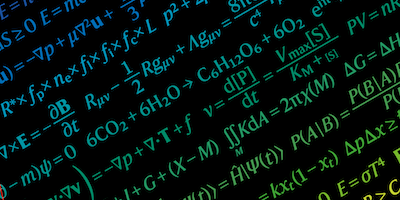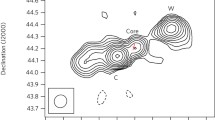Abstract
The role of mergers in producing galaxies, together with the finding that most large galaxies harbour black holes in their nuclei1, implies that binary supermassive black hole systems should be common. Here we report that the quasar SDSS J153636.22+044127.0 is a plausible example of such a system. This quasar shows two broad-line emission systems, separated in velocity by 3,500 km s-1. A third system of unresolved absorption lines has an intermediate velocity. These characteristics are unique among known quasars. We interpret this object as a binary system of two black holes, having masses of 107.3 and 108.9 solar masses separated by ∼0.1 parsec with an orbital period of ∼100 years.


Similar content being viewed by others
References
Magorrian, J. et al. The demography of massive dark objects in galaxy centers. Astron. J. 115, 2285–2305 (1998)
Komossa, S., Zhou, H. & Lu, H. A recoiling supermassive black hole in the quasar SDSS J092712.65+294344.0? Astrophys. J. 678, L81–L84 (2008)
Bogdanovic, T., Eracleous, M. & Sigurdsson, S. SDSS J092712.65+294344.0: Recoiling black hole or a sub-parsec binary candidate? Preprint at 〈http://arxiv.org/abs/0809.3262〉 (2008)
Dotti, M. et al. SDSSJ092712.65+294344.0: A candidate massive black hole binary. Preprint at 〈http://arxiv.org/abs/0809.3446〉 (2008)
Heckman, T. M., Krolik, J. H., Moran, S., Schnittman, J. & Gezari, S. SDSSJ092712.65+294344.0: NGC 1275 at z = 0.7? Preprint at 〈http://arxiv.org/abs/0810.1244〉 (2008)
Shields, G. A., Bonning, E. W. & Salviander, S. Comment on the black hole recoil candidate quasar SDSS J092712.65+294344.0. Preprint at 〈http://arxiv.org/abs/0810.2563〉 (2008)
Schneider, D. P. et al. The Sloan Digital Sky Survey quasar catalog. IV. Fifth data release. Astron. J. 134, 102–117 (2007)
Appenzeller, I. & Wagner, S. J. Forbidden high-ionization lines in QSO spectra. Astron. Astrophys. 250, 57–61 (1991)
Moore, D. & Cohen, R. D. Narrow-line region kinematics in Seyfert nuclei. Astrophys. J. 433, 602–624 (1994)
Boroson, T. A. & Meyers, K. A. The optical properties of IR-selected and Mg II broad absorption line quasars. Astrophys. J. 397, 442–451 (1992)
Vanden Berk, D. E. et al. Composite quasar spectra from the Sloan Digital Sky Survey. Astron. J. 122, 549–565 (2001)
Hu, C. et al. A systematic analysis of Fe II emission in quasars: Evidence for inflow to the central black hole. Astrophys. J. 687, 78–96 (2008)
Denney, K. D., Peterson, B. M., Dietrich, M., Vestergaard, M. & Bentz, M. C. Systematic uncertainties in black hole masses determined from single epoch spectra. Preprint at 〈http://arxiv.org/abs/0810.3234〉 (2008)
Sillanpää, A., Haarala, S., Valtonen, M. J., Sundelius, B. & Byrd, G. G. OJ 287: Binary pair of supermassive black holes. Astrophys. J. 325, 628–634 (1988)
Valtonen, M. J. et al. A massive binary black-hole system in OJ 287 and a test of general relativity. Nature 452, 851–853 (2008)
Peters, P. C. Gravitational radiation and the motion of two point masses. Phys. Rev. 136, 1224–1232 (1964)
Milosavljevic, M. & Merritt, D. Long term evolution of massive black hole binaries. Astrophys. J. 596, 860–878 (2003)
Gould, A. & Rix, H. Binary black hole mergers from planet-like migrations. Astrophys. J. 532, L29–L32 (2000)
Cuadra, J., Armitage, P. J., Alexander, R. D. & Begelman, M. C. Massive black hole binary mergers within sub-pc scale gas disks. Mon. Not. R. Astron. Soc. (in the press)
Richards, G. T. et al. The Sloan Digital Sky Survey quasar survey: Quasar luminosity function from Data Release 3. Astron. J. 131, 2766–2787 (2006)
Conselice, C. J., Gallagher, J. S. & Wyse, R. F. G. On the nature of the NGC 1275 system. Astron. J. 122, 2281–2300 (2001)
Acknowledgements
NOAO is operated by the Association of Universities for Research in Astronomy (AURA), Inc. under cooperative agreement with the National Science Foundation (NSF). This paper has used data from the SDSS archive, the 2MASS archive, the ROSAT archive at the High Energy Astrophysics Science Archive Research Center (HEASARC), provided by NASA's Goddard Space Flight Center, the FIRST survey, and the NVSS. Funding for the SDSS and SDSS-II has been provided by the Alfred P. Sloan Foundation, the Participating Institutions, the NSF, the US Department of Energy, the National Aeronautics and Space Administration (NASA), the Japanese Monbukagakusho, the Max Planck Society, and the Higher Education Funding Council for England. The SDSS website is at http://www.sdss.org/. The 2MASS is a joint project of the University of Massachusetts and the Infrared Processing and Analysis Center/California Institute of Technology, funded by NASA and the NSF.
Author information
Authors and Affiliations
Corresponding author
PowerPoint slides
Rights and permissions
About this article
Cite this article
Boroson, T., Lauer, T. A candidate sub-parsec supermassive binary black hole system. Nature 458, 53–55 (2009). https://doi.org/10.1038/nature07779
Received:
Accepted:
Issue Date:
DOI: https://doi.org/10.1038/nature07779
- Springer Nature Limited
This article is cited by
-
Electromagnetic counterparts to massive black-hole mergers
Living Reviews in Relativity (2022)
-
A candidate sub-parsec binary black hole in the Seyfert galaxy NGC 7674
Nature Astronomy (2017)
-
Balmer line shifts in quasars
Astrophysics and Space Science (2016)
-
Line shifts and sub-pc super-massive binary black holes
Astrophysics and Space Science (2016)
-
Line Shapes Emitted from Spiral Structures around Symmetric Orbits of Supermassive Binary Black Holes
Journal of Astrophysics and Astronomy (2015)





